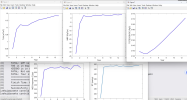Hi all,
I’m using the CLM5BGCCrop compset within CESM2_3_beta17 (CTSM5.2 tag) and also testing in CESM3_0_beta05 (CTSM5.3 tag). After going through Section 1.5.5 of the CLM User Guide and reading related forum posts, I still have a few questions about the proper spin-up procedure.
My current setup:
I'm using an official initial condition file from NCAR, which, as mentioned in forum discussions, should be already spun-up. For example:
I want to confirm whether this initial file is truly spun up.
To test its spin-up status, I ran the I2000Clm50BgcCrop compset in CESM2_3_beta17 using default settings (i.e., no code modifications), with:
· Default RUN_STARTDATE = "2000-01-01"
· Simulation length: ~10 years
· Using my own matlab code or SpinupStability.ncl to check spin-up status
Results:
(0) EQUILIBRIUM SUMMARY
(0) =======================================================================
(0) FATAL: TOTECOSYSC is NOT in equilibrium
(0) FATAL: TOTSOMC is NOT in equilibrium
(0) FATAL: TOTVEGC is NOT in equilibrium
(0) TLAI is in equilibrium. Eq. Yr. = 2006
(0) FATAL: GPP is NOT in equilibrium
(0) TWS is in equilibrium. Eq. Yr. = 2006
(0) H2OSNO is in equilibrium. Eq. Yr. = 2006
(0) FATAL: Not enough of the land surface is in equilibrium ( 80.18% > 3.00%)
(0) FATAL: Your simulation is not in equilibrium, 8 hours have been deducted from your PTO bank, try again

Soil moisture appeared stable, but carbon pools were not, which made me wonder if I had missed anything in the setup.
My questions:
1. Is this a valid approach to test whether an initial condition file is truly spun-up?
2. If I want to further spin up from this initial condition file, what’s the recommended approach? Specifically:
· Should I set RUN_STARTDATE = 0001-01-01?
· Should I enable CLM_BLDNML_OPTS="-bgc_spinup on" -append or set clm_accelerated_spinup='on'?
3. In SpinupStability.ncl, what exactly does the subper variable control? I set it to 1, assuming the I2000 configuration represents one-year cyclic forcing. Is that correct?
4. If I plan to use this I2000-based spun-up initial condition in a different compset (e.g., F2000), can I directly reuse it? Or do I need to re-spin-up within the F2000 compset? If so, is the spin-up process for F2000 the same as for I2000? And how many years does it usually take?
Any clarification or suggestions would be greatly appreciated! Thanks in advance.
Best,
Zehui
I’m using the CLM5BGCCrop compset within CESM2_3_beta17 (CTSM5.2 tag) and also testing in CESM3_0_beta05 (CTSM5.3 tag). After going through Section 1.5.5 of the CLM User Guide and reading related forum posts, I still have a few questions about the proper spin-up procedure.
My current setup:
I'm using an official initial condition file from NCAR, which, as mentioned in forum discussions, should be already spun-up. For example:
I want to confirm whether this initial file is truly spun up.
To test its spin-up status, I ran the I2000Clm50BgcCrop compset in CESM2_3_beta17 using default settings (i.e., no code modifications), with:
· Default RUN_STARTDATE = "2000-01-01"
· Simulation length: ~10 years
· Using my own matlab code or SpinupStability.ncl to check spin-up status
Results:
(0) EQUILIBRIUM SUMMARY
(0) =======================================================================
(0) FATAL: TOTECOSYSC is NOT in equilibrium
(0) FATAL: TOTSOMC is NOT in equilibrium
(0) FATAL: TOTVEGC is NOT in equilibrium
(0) TLAI is in equilibrium. Eq. Yr. = 2006
(0) FATAL: GPP is NOT in equilibrium
(0) TWS is in equilibrium. Eq. Yr. = 2006
(0) H2OSNO is in equilibrium. Eq. Yr. = 2006
(0) FATAL: Not enough of the land surface is in equilibrium ( 80.18% > 3.00%)
(0) FATAL: Your simulation is not in equilibrium, 8 hours have been deducted from your PTO bank, try again

Soil moisture appeared stable, but carbon pools were not, which made me wonder if I had missed anything in the setup.
My questions:
1. Is this a valid approach to test whether an initial condition file is truly spun-up?
2. If I want to further spin up from this initial condition file, what’s the recommended approach? Specifically:
· Should I set RUN_STARTDATE = 0001-01-01?
· Should I enable CLM_BLDNML_OPTS="-bgc_spinup on" -append or set clm_accelerated_spinup='on'?
3. In SpinupStability.ncl, what exactly does the subper variable control? I set it to 1, assuming the I2000 configuration represents one-year cyclic forcing. Is that correct?
4. If I plan to use this I2000-based spun-up initial condition in a different compset (e.g., F2000), can I directly reuse it? Or do I need to re-spin-up within the F2000 compset? If so, is the spin-up process for F2000 the same as for I2000? And how many years does it usually take?
Any clarification or suggestions would be greatly appreciated! Thanks in advance.
Best,
Zehui
